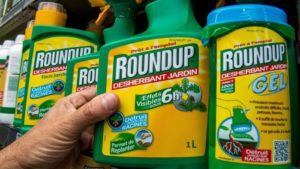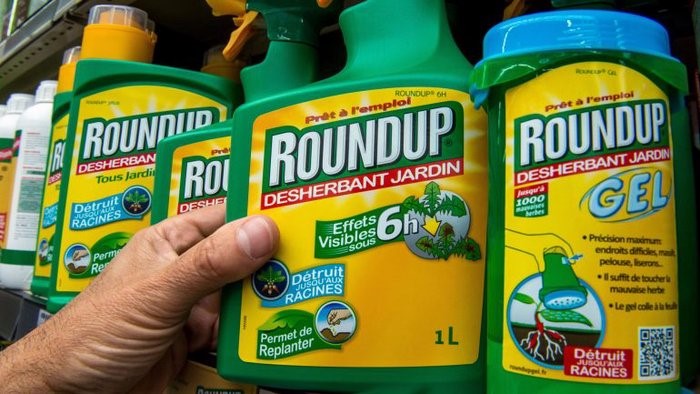
RoundUp, herbicida comercializado pela Monsanto, cujo ingrediente ativo é o glifosato
Fonte: Observador
Em 2015, o mesmo foi classificado como “carcinogéneo provável para o ser humano e carcinogéneo provado para animais de laboratório” pela IARC – International Agency for Research on Cancer, órgão da Organização Mundial de Saúde. Não obstante, a 27 de novembro de 2017, a licença do uso do glifosato foi renovada por mais cinco anos na União Europeia, votação na qual Portugal se absteve.
Ainda no ano passado, a multinacional Monsanto, comercializadora do RoundUp, cujo ingrediente ativo é o glifosato, foi acusada de omissão de dados relativamente à inocuidade e biodegradabilidade do herbicida, tendo sido revelado documentos, pelo departamento de justiça norte americana, que comprovam o conhecimento por parte da empresa da perigosidade do mesmo desde 1999. Contudo, a Monsanto continua a criticar as motivações e limitações do estudo da IARC.
Com o intuito de averiguar o grau de urgência da proibição do glifosato em Portugal e o escândalo relativo à multinacional Monsanto, entrevistou-se duas personalidades com atividade notável a nível ambiental.
Mário Carvalho, professor no Departamento de Fitotecnia na Universidade de Évora, inicia a entrevista por acentuar o facto de o controlo dos infestantes ser indispensável para a produção de alimentos, sendo a mobilização do solo e o uso de herbicidas duas formas fundamentais de obter este controlo. No entanto, “A mobilização do solo acarreta consequências ambientais, entre as quais a perda de solo por erosão e a degradação do seu teor em matéria orgânica”. Deste modo, a proibição da utilização de herbicidas, como o glifosato, conduzirá ao inevitável aumento da intensidade da mobilização do solo, o que, por sua vez, agravará todas aquelas consequências. É de realçar que a excessiva mobilização do solo é um problema que se tem vindo a intensificar em Portugal.
Quando questionado até que ponto o cidadão comum deve estar preocupado com a prevalência da utilização do glifosato, o entrevistado reconhece que o problema deriva do abuso do herbicida, nomeadamente do seu “uso em contexto não agrícola, como os passeios das cidades ou ao longo de estradas, e em culturas geneticamente modificadas resistentes ao mesmo, tarefa para a qual se recorrem a quantidades muito mais elevadas para matar os infestantes”. Todavia, ressalva que, na Europa, esta última variedade do herbicida está proibida.
Por outro lado, colocada a mesma questão, Margarida Silva, Professora na Escola Superior de Biotecnologia na Universidade Católica do Porto, evidencia que, apesar do glifosato não ser o único pesticida “que desequilibra o ambiente e nos causa múltiplas doenças, é daqueles em que já há conhecimento científico suficiente para justificar uma proibição definitiva do seu uso”, o que está de acordo com a sua classificação como o herbicida mais estudado pela comunidade científica. “E é por isso, porque o glifosato continua a ser usado, apesar de ser venenoso, que há razão para as pessoas se preocuparem”, remetendo a entrevistada para “análises que mostram que é abundante no ar, solo, chuva, água de consumo, bebidas, muitos tipos de alimentos e até leite materno e urina humana.”
É de notar que, em 2016, análises da urina de 26 voluntários portugueses revelaram a presença de glifosato em todas as amostras. Ademais, a entrevistada assegura que “Os portugueses, tanto quanto se sabe, são as pessoas mais contaminadas por glifosato na Europa – vinte vezes mais que os alemães, por exemplo. A proibição em Portugal já devia ter vindo há muito tempo”.
Em relação ao predomínio do uso do glifosato, o investigador do ICAAM – Instituto de Ciências Agrárias e Ambientais Mediterrânicas -, justifica a sua popularidade, por ser o único herbicida total, ou seja, mata a generalidade das plantas e não é residual: após a sua aplicação pode semear-se qualquer cultura e evitar a mobilização do solo.
Sob outro ponto de vista, a doutorada em Biologia Molecular, acusa a cultura dos transgénicos como causa maior da prevalência do glifosato, já que “no seu conjunto, os transgénicos absorvem 56% de todo o glifosato consumido anualmente a nível mundial”, sendo que 72% do total de glifosato aplicado mundialmente nos últimos 40 anos foi aplicado na última década”.
Além disso, e tendo como ponto de partida o plano de redução do uso de pesticidas, em vigor no país, declara que “na prática há medo de obrigar os agricultores a cortar nos químicos.” Por isso, os avanços são reduzidos e para já, “só os cidadãos podem travar o glifosato ao forçar as câmaras a mudar para meios não químicos de limpeza de ruas e, sempre que possível, o ideal é comprar alimentos biológicos.”
Confrontado com a polémica da Monsanto, Mário Carvalho realça a inevitabilidade dos interesses comerciais por parte de qualquer produto independentemente dos efeitos nocivos ou secundários a nível humano e/ou ambiental e acredita que “existe um grande envolvimento ideológico na discussão do glifosato. Muita da informação que aparece como independente a denegri-lo não é séria do ponto de vista científico, o que não significa que este seja inócuo para o ambiente”. Todavia, “há um grande saldo a favor das vantagens.”
Numa outra perspetiva, Margarida Silva alega que “Historicamente a Monsanto tem uma cultura de mentira e corrupção.”, relembrando a defraudação nas conclusões de um estudo, na década de 70 do século passado, relativo à poluição altamente tóxica de um rio no Alabama, devido à presença do químico PCB, usado na indústria elétrica e comercializado pela empresa. Acrescenta que “Quanto ao glifosato a Monsanto fez tudo o que estava ao seu alcance – legal ou ilegal, justo ou injusto – para impedir que o glifosato fosse proibido, o que passou também por manipular a ciência em toda a linha.”, concluindo “Os interesses comerciais são a única razão para a Monsanto defender o glifosato. Afinal, em 2015, os herbicidas à base de glifosato renderam mais de mil milhões em lucros, só à Monsanto.”
A Professora entrevistada salienta igualmente o exemplo de França, que anunciou que vai preparar os seus agricultores para abandonar o uso glifosato antes de 2022. “Se uma das maiores potências agrícolas europeias pode passar sem glifosato, nós também podemos. A nossa saúde é que já não pode passar sem a sua proibição.”
O uso do glifosato permanece um tema controverso, estando ainda em aberto, o processo de análise cuidada e fundamentada dos factos por órgãos da justiça, que permitirá o apuramento da verdade. Contudo, cada um de nós, enquanto cidadãos ativos com sentido crítico, deve desenvolver a sua opinião. Assim se justifica a inclusão neste artigo de duas posições distintas, que, decerto, contribuirão para a formação de juízos justificados e para a reflexão sobre as possíveis consequências que o desenvolvimento industrial e tecnológico acarreta para o ambiente e para o próprio Homem.
Agradece-se à Professora Doutora Margarida Silva e ao Professor Doutor Mário Carvalho pela disponibilidade e amabilidade em responder às questões que lhes foram colocadas para a realização deste artigo.
Glyphosate is the most popular herbicide worldwide and Portugal is no exception. According to the French newspaper Le Monde, this weedkiller is present in around 750 products traded by 100 companies in more than 130 countries (Figure 1).

Figure 1 – Glyphosate is the active ingredient of RoundUp, manufactured by Monsanto Source: Le Monde.
In 2015, the IARC – International Agency for Research on Cancer, part of the WHO – World Health Organisation – classified glyphosate as “probably carcinogenic to humans” and it was proved as carcinogenic in animal models. Nevertheless, on the 27th November 2017, the European Commission reauthorised its use for more 5 years, voting from which Portugal abstained.
The multinational Monsanto, acquired by Bayer last year, has been commercialising RoundUp, whose active ingredient is glyphosate, since 1974. In 2016, it was nonetheless accused of omission regarding the innocuity and biodegradability of herbicide, after the Department of Homeland Security (U.S.) – DHS – revealed compromising documents, confirming knowledge of the dangers associated with glyphosate since 1999. Facing these accusations, Monsanto keeps criticising the motivations behind and the limitations of the aforementioned IARC study, arguing the safety of the weedkiller for human health.
Aiming at evaluating the situation in Portugal as well as understanding at what extent an effective ban of glyphosate is required in the country, especially after the scandal involving Monsanto, I interviewed two well-known Portuguese personalities with active environmental participation.
Professor Mário Carvalho, lecturer in Plant Science at the University of Évora, Portugal, starts the interview by highlighting that pest control is pivotal for agriculture and implicitly for food production. In this sense, “tillage and herbicide use are two of the most important ways to attain this, despite the fact that the first one has a severe impact on the environment, including soil erosion and organic matter degradation. Hence, a glyphosate ban would inevitably lead to an increase in tillage, which, in turn, would aggravate the situation mentioned above. It is worth noticing that excessive tillage is a problem that has been worsening in Portugal throughout the years.
About the extent at which we should be worried about the current use of glyphosate, Professor Carvalho recognizes that the problem arises from its inappropriate usage, particularly non-agricultural uses, such as in pavements, roads and even in genetically modified crops. The latter require extremely high amounts of herbicide to kill all the pests; in the European Union, this most potent variety is, however, not allowed.
When asked the same question, Professor Margarida Silva, lecturer at the Catholic University of Portugal – School of Biotechnology, emphasises that, even though glyphosate is not the only herbicide which is toxic for the environment and human health, there is already enough scientific knowledge to ban it definitely: indeed, glyphosate is the most studied herbicide by the scientific community. “Since it keeps on being used, regardless of its toxicity, we should worry.“. The interviewee recalls past studies that have shown the abundance of glyphosate in the air, soil rain, drinking water, drinks, foods, and even breast milk and human urine. As a matter of fact, in 2016, urine samples of 26 Portuguese volunteers, revealed the presence of glyphosate in all of them. Professor Silva argues that “as far as it is known, the Portuguese are the most contaminated people in Europe, 20 times more than the Germans. In Portugal, the ban should have been implemented long ago.”.
Regarding its persistence in agriculture, Professor Carvalho justifies its popularity based on its efficaciousness, inasmuch as it kills most plants and does not remain in the soil. This means that after the application, other crops can be harvested, avoiding the damaging soil tillage. In contrast, Professor Silva accuses transgenic crops of being the largest cause behind the persistence of glyphosate, since “all together they absorb 56% of the glyphosate used annually worldwide. Besides, 72% of the glyphosate that was used in the world in the last forty years was applied in the past decade.”.
Moreover, and taking into account the plans for reducing the use of pesticides in Portugal, she reveals that “in reality, there is fear about forcing the farmers to decrease their use. The progress is thus slow and, at the moment (January 2018), only the civil society can prevent the use of glyphosate by pressing city councils for the replacement of the chemicals applied in street cleaning, and, also by buying organic food.”.
About the controversy surrounding Monsanto, Professor Carvalho says that the multinational’s economic interest is inevitable as in any other company, irrespective of the harmful side effects. He considers that there is a significant ideological involvement when it comes to the debate around glyphosate. “A significant fraction of the information that is released and spread about its toxicity does not have scientific credibility, which does not mean it is innocuous to the environment. However, the advantages outweigh the disadvantages.”.
Professor Silva stresses the “history of lie and corruption of Monsanto”, more specifically the fraud involving the conclusions of a study, carried out in the 1970s, about the polychlorinated polyphenyl – PCB – contamination of river water in Alabama. This chemical used to be commercialised by the company and it was commonly used in the electric power industry. She adds that “Monsanto did everything it could – legal or illegal, fair or not – to prevent the ban of glyphosate, including manipulation of scientific studies, only because of financial reasons.”. After all, in 2015, the company made profits of more than four billion USD solely from glyphosate-based herbicides. Concerned with the situation in the country, the researcher concludes with the example of France, which has announced it is preparing the farmers for abandoning glyphosate before 2022; “if one of the biggest European agricultural powers can manage without it, Portugal can as well.”.
In 2019, glyphosate remains a controversial topic and it is still highly discussed, with many details to be clarified. Nevertheless, critical thinking is fundamental to reflect upon and develop individual opinions about the present use of glyphosate and eventual bans or restrictions, in Portugal and other countries. This was the main motivation behind writing an article presenting two different perspectives, which may hopefully contribute to the discussion and evaluation of the “pros” and “cons” as well as help to consider the potential impact further industrial and technological development might have in the environment and public health.
I would like to thank Professor Mário Carvalho and Professor Margarida Silva for their kind availability in answering my questions.




You must be logged in to post a comment.